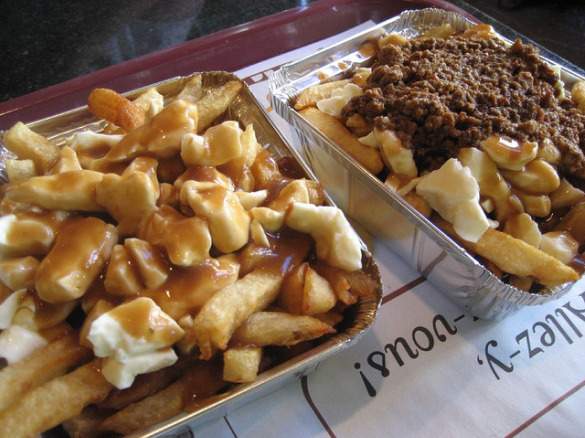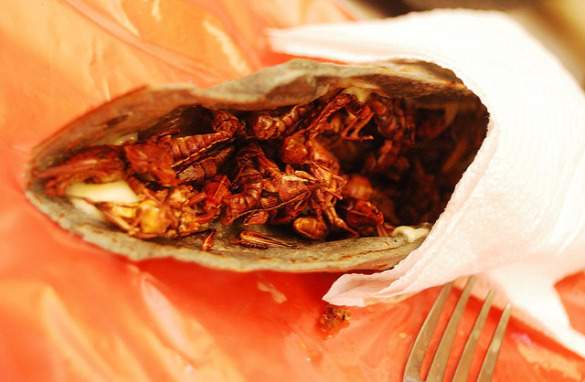If you were to ask my husband what his favorite part of epic world travel is, he’d tell you, without hesitation, “the food!” and at least two of our four kids agree. With culinary connoisseurs along for the ride, we take every opportunity to sample the local fare. Our very favorite places to eat? On the street!
Street food is often cheap, tasty, and in many cases, more sanitary than food cooked in restaurants (anything you can watch cooked in front of you is a safe bet), plus there’s no better way to taste the food of the people – those cheap eats enjoyed by locals of all ages and incomes. Join us for a quick tour of eleven of our all time favorite street foods.
[social]
Gelato
We’ve had ice cream in Wittenberg, homemade custard in New England, lemon ices in Canada, but nowhere (and I mean nowhere) have we had anything better than the gelato in Venice. Gelato was first created in the Dolomite region of Italy using milk, eggs, cream, sugar and natural flavoring. The makers of this sweet treat would store snow in cold basements to turn into gelato to sell in the summertime to rich visitors to the town. With a lower fat content than the American version of ice cream, it’s a treat for your taste buds with less impact on your waistline! At about 2.50 EU for the small cone, it’s worth the cost of airfare just to close your eyes and savor the moment.
>> Read more about gelato flavors
>> Learn how to order gelato in Italy
Chicken on a stick
In New Orleans, or on the sidewalks of Seoul and a hundred other places in between. What makes this street food rock? It’s versatility. It can be had deep fried, southern style, grilled to perfect tenderness and painted with BBQ sauce, with a side of Nuoc Cham or skewered with onions caramelized to perfection on the fire. Chicken on a stick is a cross cultural phenomenon that begs to be tried wherever it’s found, just for the sake of the cultural experience of trying them all.
>> Book hostels in New Orleans
Fried dough
Beaver Tails in Canada, Elephant Ears in the midwestern USA, Churros in Mexico – by any other name it tastes as sweet. This is street food at its finest. The Ancient Egyptians ate it, and so has just about every culture since. Whether sweet, or savory, flat or in balls, with holes or without, frying dough is a cross-cultural commonality throughout history. Many cultures have special fried doughs associated with certain holidays or events, like Zeppole for Christmas in Italy, or Loukoumades for Christmas in Greece.
In the USA, you’re likely to find fried dough most often at county or state fairs throughout the summer and fall. Dough, deep fried, topped with sugar, apples, cherries, cinnamon, coconut, whipped cream, or chocolate sauce… the topping choices are endless, and what makes this sticky delight a perennial favorite on all continents.
>> Discover seven classic American food festivals
Falafel
“Falafel is not awful!” to quote my daughter, who was quite surprised to find that she really liked this fried vegetarian delight. If you’re not a meat eater, this street food definitely rocks. It’s nutritious, delicious and no animals were harmed in its making. A middle-eastern specialty made of ground chickpeas and/or fava beans that are seasoned and fried, falafel has been adopted as the national snack of Israel. The story is that the Coptic Christians first created this as a meat replacement during Lent.
Enjoyed widely across the Mediterranean-Arab world, falafal can also be found on the streets of cities in Europe, New York, LA and Chicago, to name a few. If you buy it on the street, it’s likely to come packaged in a pita bread with some salad or olives on top and a creamy white sauce that lends the perfect tang to the dish.
Shrimp cocktail
The shrimp cocktail sauce in Veracruz, Mexico is not your mother’s shrimp cocktail, so don’t expect it to come with bottled sauce. Since it’s a local delicacy, every street side cafe will have their signature version with lime, cilantro, onion, and a dash of hot sauce, but why sit down? Strolling vendors with carts and wheel barrows will be selling plastic cups of the stuff, kept cool on ice, with a plastic spoon on the side. Not classy, perhaps, but very Veracruz. For extra culture points, eat it one evening on the zocalo while watching (or dancing?) the danzon; truly, it’s not to be missed. Just makes sure the shrimp is fresh and cold.
>> Book a culinary tour of Mexico
Doners
An absolutely heavenly “sandwich” of Turkish influence that can be found cheap all over Europe, doner is traditionally made with roasted lamb meat, but sometimes beef or chicken, and salad on a round of flat bread with a tangy white yogurt sauce. With it’s origins in Ottoman turkey and variants found as far and wide as the Philippines, Australia and the Netherlands, you’re likely to find a doner somewhere on your travels. The Germans are known for their particular spin on the “doner kebab”, with at least one doner stand in the central square of nearly every town. Order it “scharf” to get a hotter sauce and have it sprinkled with hot pepper flakes.
Poutine
Poutine is perhaps Canada’s (unofficial) national dish, and if it’s not, it should be. Affectionately nicknamed a “heart attack on a plate,” your arteries may not thank you, but your taste buds will. What is it? French fries topped with a “secret” brown gravy, topped with a special white Canadian cheese curds that squeaks against your teeth when you chew it. Its origins are disputed, but credit is generally given to Fernand Lachance who, when asked by a patron to put cheese on his take-out fry order exclaimed, “ça va faire une maudite poutine.” (“Translation – it will make a damn mess.) And so the dish was born and named all at once.
The best place to try it is in Montreal, it’s point of origin where most greasy spoon diners and any street vendor with a deep frier will be likely to have it. If you really fall in love, you can always buy the T-shirt. That’s right, this dish has it’s own t-shirt: a picture of the gravy covered, cheesy, fried goodness with the caption, “Body by Poutine.”
>> Read more about eating poutine in Canada
The street sausage
It’s available worldwide, from pushcarts in Chicago and Ottawa to the ‘burgs of Germany and beyond; everyone seems to have their local sausage that is the best and not to be missed. I say, try them all. What makes street sausage rock? Their universal appeal and the endless variety. Every culture has their own spin on sausage and as if that weren’t enough, the toppings can take an ordinary frankfurter and turn it into fusion cuisine. Case in point: the Kimchi-Bulgogi dog at New York Hotdog & Coffee on Bleeker Street in NYC. Get a grilled Linguica from the Portugese influence near Cape Cod, or order a narrow sausage as long as your arm, served dripping out both ends of a crusty bakery roll at an alstadt fest in Germany. Where ever you go, you’re likely to find a sausage if you look!
Corn
From midwestern state fairs to street vendors throughout Central America, to push carts in Indonesia, corn is one of the only veggies, besides the potatoe, to develop a solid following as a street food. (I know, it’s actually a grain.) It’s typically sold boiled whole, or grilled, and mounted on a stick. What makes it rock are the various coatings: order it dripping with butter, or with a squeeze of lime and chile in Mexico, or sprinkled with a crumbly white cheese in Central America. Etiquette for eating it? Roll up your sleeves and prepare to get messy! The best part of street food is the ability to make a mess outside, right? If a little drips off your chin, so much the better. You just might want to carry some floss in your pocket. Corn also appears fried into fritters and if you are really lucky, you’ll find it cut off the cob cooked with little bits of sweet red pepper, dipped into paper cups and topped off with cream.
Carne asada
Most travelers enter the third world terrified of food borne illness; my Dad taught me early that the safest food to eat is that which you watch being cooked right in front of you. Enter the carne asada – grilled meat, usually minced up and served in a hot corn tortilla. A northern Mexican tradition born out of the native people’s love affair with corn made into tortillas and fire roasted meats, this delicacy is as diverse in flavor as the places you’ll find to eat them. The unique “homemade” quality of each vendor’s specific marinade for the meat, or particular blend of toppings are what makes this dish so special, and so diverse. Be sure to try it al pastore, with pineapple, nopales (cactus paddle) mangoes, cilantro, several types of cheese and with every kind of grandma-made salsa you can manage.
Chapulines
The snack of choice in Oaxaca, Mexico, it is said that if you taste these crunchy delights, you’ll fall in love with the place and never leave. Harvested in spring through early summer, the chapulines (grasshoppers) are carefully cleaned, washed and toasted with garlic, lemon and salt seasoned with the extract of agave worms. They are tangy and crunchy, and don’t taste half bad, but personally, I have a hard time getting past the legs. You can buy chapulines all over the state of Oaxaca, piled high in woven baskets, dusted with chile, and squeezed lightly with lime. They’re a popular snack at sporting events and on weekend evenings in the Zocalo. Who knows how long they’ve been a delicacy? They were being eaten when the conquistadors arrived, and likely for many years before that. How’s that for an authentic, old school, street food that really rocks?
>> Discover ten weird food delicacies from around the world
What’s your favorite street food? Read more about eating on the street:
- Six Places to Find Great and Exotic Street Food
- How I Travel: Anthony Bourdain
- Exciting Edibles in South America
- Eat Your Way Around Bangkok
Photos by roboppy, Southern Foodways Alliance, Purrrpl_Haze, roboppy, Sifu Renka, Tony Mille, Bill on Capitol Hill, annamatic3000, Ed Yourdon, Tony Miller, martintoy










